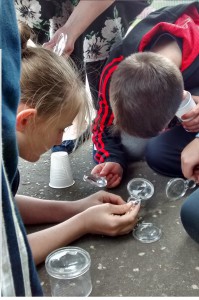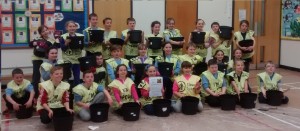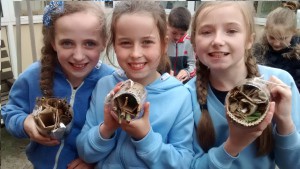
Since the start of my placement at CSGNT in January I have been working closely with St Mary’s primary school in Coatbridge, especially the P5 class. It began as a consultation to find out how the pupils would like to improve the public areas surrounding their school and after many ideas, discussions and changes of plan(!) the project is now focussed on improving the external aesthetics of the school, encouraging active travel to school and increasing environmental awareness and active, healthy lifestyles. The project can be divided into two parts;
1) A 10 week engagement plan and activity sessions run by myself at the school. Many of the sessions are linked to 6 new wooden planters which I have ordered for the school.
2) The creation of pavement artwork which includes fun and engaging activities (hopscotch grids, mazes etc) but also road safety aids (safe crossing points and ‘Stop. Look. Listen’ messages). Also signage for the school boundary fence.
Instead of boring you with details and processes of the North Lanarkshire Council planning department, I’ll tell you a bit about the engagement sessions I have been running with the P5 class over the last few weeks……
Session 1 – Planting seeds
Once the planters are delivered (hopefully next week!) we’ll need something to plant in them. This week we planted runner bean, sweet pea and nasturtium seeds into pots. These tall climbing plants will produce a colourful and edible display which will help to soften the appearance of the school boundary fence while attracting insects and birds to the school grounds. They also planted a sunflower each – there will be a prize for the pupil whose sunflower has grown the tallest by the end of term!
Session 2 – Making stencils
The children have decided they would like to decorate the planters so this week we set about making stencils which we can use to paint pictures on the planters once they are delivered. It was a bit tricky and took a while for some of the children to get their heads around cutting out the inside of the picture rather than the outside but by the end of the afternoon we had made lots of flower, butterfly, caterpillar, fruit and vegetable stencils.
Session 3 – Bug houses
I had asked the children to bring a large bottle with them this week which we could cut the top off and fill up with things like twigs, hay, dry leaves, hollow plant stems and corrugated cardboard to make lots of little nooks and crannies for bugs to hide in. We tied string to the bottles so they can be tied to trees or hung up in their gardens at home. Having successfully made a bug house each we then had a discussion about what bugs might move in and why it is advantageous to have insects, bugs and creepy crawlies in your garden.
Session 4 –Bug survey
To follow on from the bug houses we made last week we  carried out a bug survey in the school grounds. I had downloaded and printed all of the resources from the OPAL website and in three groups the children look for mini-beasts on soft ground, hard ground and on plants. Lots of beasties were found, 56 in total, including worms, ants, beetles, spiders, woodlice and a bee. It was very exciting for the children to know that the bugs they counted would feed into a nationwide data set so experts can analyse the populations of the little critters.
carried out a bug survey in the school grounds. I had downloaded and printed all of the resources from the OPAL website and in three groups the children look for mini-beasts on soft ground, hard ground and on plants. Lots of beasties were found, 56 in total, including worms, ants, beetles, spiders, woodlice and a bee. It was very exciting for the children to know that the bugs they counted would feed into a nationwide data set so experts can analyse the populations of the little critters.
The planters are being delivered next week then we can start planting out the little bean, sweet pea and nasturtium plants, sowing more seeds and decorating the outside of the planters. One of the planters is going to be a butterfly garden too so there is plenty to be done before the end of term! Keep an eye out for my next blog and I’ll let you know what else we’ve been up to!

